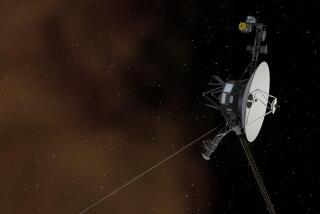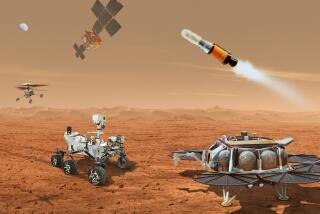After discovering more than 2,600 planets, NASA’s Kepler space telescope is headed for retirement
- Share via
The time has come to say good night to NASA’s revolutionary Kepler space telescope.
For nearly a decade, the intrepid planet-hunter has peered deep into the sky to reveal a universe teeming with previously unknown worlds around distant stars.
By discovering more than 2,600 confirmed planets, Kepler launched a new era of exploration and redefined humanity’s place in the cosmos, said Paul Hertz, director of NASA’s astrophysics division in Washington, D.C.
But now the spacecraft is out of fuel.
NASA officials will send the final commands to turn off its transmitter and disable its default protections within the next week, they announced Tuesday.
Then Kepler will drift into an eternal sleep in a safe orbit around the sun, trailing the Earth at a distance of 94 million miles.
“We collected every last bit of science data, and in the end, we didn’t have a drop of fuel left over for anything else,” said Charlie Sobeck, the Kepler mission’s former project manager and chief engineer at NASA’s Ames Research Center in Mountain View, Calif.

Before Kepler launched in 2009, nobody knew whether planets like the ones in our solar system were common or rare in the cosmos.
The telescope’s steady, persistent gaze revealed that there are more planets than stars in our galaxy.
In addition, data collected by Kepler suggest that 20% to 50% of those stars should have at least one Earth-sized planet at the right distance from its star to allow water to pool on its surface. Scientists believe this is a prerequisite for life as we know it.
Kepler also showed astronomers that the universe is made up of a great diversity of planets, including many that have no counterpart in our solar system, said Jessie Dotson, the Kepler project scientist at Ames Research Center.
Among the menagerie, Kepler found small planets orbiting their stars so quickly that rocks would melt, and gas giants so much bigger than Jupiter that they would rival small stars.
The telescope also discovered a new class of previously unknown planets: super-Earths, which are bigger than our planet but smaller than Neptune.
Among some of its more unusual finds was Kepler-16b, which orbits a binary star system. If you were to stand on the surface of this planet, you would see two suns in the sky.
Kepler-22b is a world blanketed by a liquid ocean. Kepler-444 is an ancient solar system that hosts five rocky planets formed 2 billion years before our own.
“It’s almost like imagination is not the limit at all,” Dotson said.
Scientists and engineers consider the mission a huge success, but it was not without its share of obstacles.
The telescope launched on March 6, 2009, with an initial mission that was scheduled to last 3½ years. Its first assignment was to focus on about 150,000 stars clustered in the constellation Cygnus.
Kepler detected potential planets by watching for minuscule dips in starlight that result when a planet passes in front of its parent star.
“It’s like trying to detect a flea crawling in front of a car headlight, when the car is 100 miles away,” said William Borucki, the architect of the Kepler mission who retired three years ago.
To achieve this level of precise observation, the telescope had to remain extremely still, which it did with the help of four reaction wheels.
One of those wheels failed in 2012, but the remaining three were enough to prevent Kepler from wobbling. Then a second wheel failed in 2013, threatening to bring the mission to an end.
That prospect brought some scientists to tears.
Then engineers came up with a clever fix, using pressure from tiny particles of sunlight to help hold the spacecraft in place. With this virtual third wheel, Kepler was back in business for a new mission, dubbed K2.
In a nine-day engineering test to see whether the new positioning method would work, the telescope spotted a super-Earth that was 2½ times wider than Earth with about 12 times as much mass.
“I thought of it as the little spacecraft that could,” Dotson said. “It always did everything we asked of it, and sometimes more.”
In its second life, Kepler shifted its position every few months. It examined a variety of targets that included proto-stars, galaxy clusters and supernovae.
By the time the K2 mission ended, Kepler had surveyed more than half a million stars, NASA said.
Mission engineers knew that Kepler wouldn’t function forever. The space telescope relies on fuel-powered thrusters to turn it toward Earth to downlink data, and that fuel would one day run out.
Sobeck said his team started watching the fuel carefully over the summer when they got the first indications that it might be running low.
By mid-September they realized the spacecraft could no longer point with its customary precision.
By mid-October, it was running on fumes.
But even as the Kepler mission comes to a close, NASA’s next planet-hunting space telescope is already scouring the skies for planets around 200,000 nearby stars.
The Transiting Exoplanet Survey Satellite, or TESS, launched in April and is focused on finding stars just 300 light-years away, or about 10 times closer than most of the stars surveyed by Kepler.
Scientists have started analyzing the first sets of data that TESS has sent down and are already finding promising planet candidates, said Padi Boyd, a TESS project scientist at NASA’s Goddard Space Flight Center in Greenbelt, Md.
Future missions, including the James Webb Space Telescope, will further investigate these planets to see whether there are any indications of life.
But Kepler will always have the distinction of being the first space telescope to prove that planets are abundant in the universe.
Sobeck said that as a kid watching “Star Trek,” he had no problem believing that there were planets of all kinds in the cosmos. Even so, Kepler’s evidence that they exist hit him like a sledgehammer to the chest.
“There is a big difference between believing a thing and knowing it,” he said.
Do you love science? I do! Follow me @DeborahNetburn and “like” Los Angeles Times Science & Health on Facebook.
MORE IN SCIENCE
UPDATES:
7:32 p.m.: This article has been updated with additional information throughout.
2:10 p.m. This article has been updated with additional comments from scientists and information about the K2 mission.
1:20 p.m. This article has been updated with comments from scientists and additional information about the Kepler mission.
This article was originally published at 12:25 p.m.







